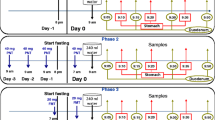Abstract
Abnormally low rates of gastric acid secretion (hypochlorhydria) are associated with bacterial overgrowth, enteric infection, and with hypergastrinemia and an increased risk of gastric neoplasms. In the present study, we evaluated the ability of fasting gastric juice pH measurements to detect true hypochlorhydria. True hypochlorhydria was defined as a peak acid output in response to a maximally effective stimulant of acid secretion that was below the lower limit of normal for 365 consecutive healthy subjects. In these healthy subjects, average basal pH was 2.16±0.09 in men and 2.79±0.18 in women. In 109 consecutive experiments in 28 subjects with true hypochlorhydria, fasting gastric pH averaged 7.44±0.11 in men and 7.65±0.33 in women. Fasting pH exceeded the upper 95% confidence limit of normal (5.09 in men and 6.81 in women) in 102 of the 109 experiments (94%). Thus, fasting pH measurement was a sensitive method for diagnosing bona fide hypochlorhydria.
Similar content being viewed by others
References
Du Moulin GC, Paterson DG, Hedley-Whyte J, Lisbon A: Aspiration of gastric bacteria in antacid-treated patients: A frequent cause of postoperative colonisation of the airway. Lancet 1:242–245, 1982
Giannella RA, Broitman SA, Zamcheck N: Influence of gastric acidity on bacterial and parasitic enteric infections. Ann Intern Med 78:271–276, 1973
Sack GH, Pierce NF, Hennessey KN, Mitra RC, Sack RB, Mazumder DNG: Gastric acidity in cholera and noncholera diarrhoea. Bull WHO 47:31–36, 1972
Ekman L, Hansson EL, Havu N, Carlsson E, Lundberg C: Toxicological studies on omeprazole. Scand J Gastroenterol 20(suppl 108):53–69, 1985
Larsson H, Carlsson E, Mattsson H, Lundell L, Sundler F, Sundell G, Wallmark B, Watanabe T, Hakanson R: Plasma gastrin and gastric enterochromaffinlike cell activation and proliferation. Studies with omeprazole and ranitidine in intact and antrectomized rats. Gastroenterology 90:391–399, 1986
Carney JA, Go VLW, Fairbanks VF, Moore SB, Alport EC, Nora FE: The syndrome of gastric argyrophil carcinoid tumors and nonantral gastric atrophy. Ann Intern Med 99:761–766, 1983
Borch K, Renvall H, Liedberg G: Gastric endocrine cell hyperplasia and carcinoid tumors in pernicious anemia. Gastroenterology 88:638–648, 1985
Moore EW, Scarlata RW: The determination of gastric acidity by the glass electrode. Gastroenterology 49:178–188, 1965
Feldman M: Gastric secretion in health and disease.In Textbook of Gastrointestinal Disease, 4th ed. MH Sleisenger, JS Fordtran (eds). Philadelphia, WB Saunders, 1988, pp 713–734
Ramsey EJ, Carey KV, Peterson WL, Jackson JJ, Murphy FK, Read NW, Taylor KB, Trier JS, Fordtran JS: Epidemic gastritis with hypochlorhydria. Gastroenterology 76:1449–1457, 1979
Winkelstein A: The diagnosis, incidence, and significance of essential achlorhydria. Am J Med Sci 203:419–428, 1942
Callender ST, Retief FP, Witts LJ: The augmented histamine test with special reference to achlorhydria. Gut 1:326–336, 1960
Card WI, Sircus W: AnacidityIn Modern Trends in Gastroenterology (Second series). F Avery Jones (ed). London, Butterworths, 1958, pp 177–192
Gastric secretion.In Physiology of the Digestive Tract, 2nd ed. HW Davenport (ed). Chicago, Year Book Medical Publishers, 1966, p 104
Gastritis, anaemia and hyposecretion.In Clinical, Tests of Gastric Secretion. JH Baron (ed). New York, Oxford University Press, 1979, pp 79–85
Shay H, Komarov SA, Berk JE: Some fallacies in the clinical measurement of gastric acidity with special reference to the histamine test. Gastroenterology 15:110–117, 1950
Grossman MI, Kirsner JB, Gillespie JE: Basal and histalogstimulated gastric secretion in control subjects and in patients with peptic ulcer or gastric cancer. Gastroenterology 45:14–26, 1963
Feldman M, Richardson CT, Lam SK, Samloff IM: Comparison of gastric acid secretion rates and serum pepsinogen I and II concentrations in occidental and oriental duodenal ulcer patients. Gastroenterology 95:630–635, 1988
Author information
Authors and Affiliations
Additional information
This work was supported by the National Institute of Healthy (DK 16168) and by the Department of Veterans Afffairs.
Rights and permissions
About this article
Cite this article
Feldman, M., Barnett, C. Fasting gastric pH and its relationship to true hypochlorhydria in humans. Digest Dis Sci 36, 866–869 (1991). https://doi.org/10.1007/BF01297133
Received:
Accepted:
Issue Date:
DOI: https://doi.org/10.1007/BF01297133




